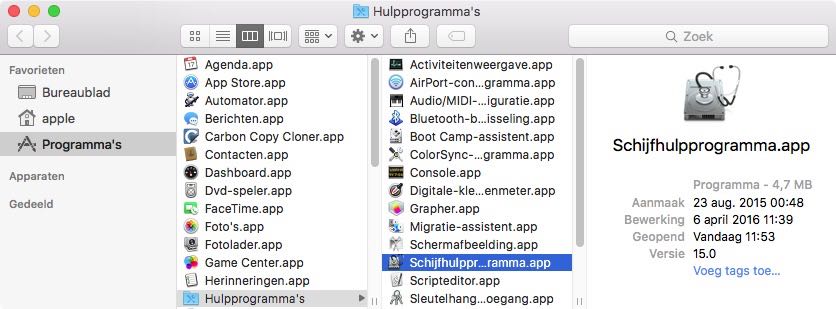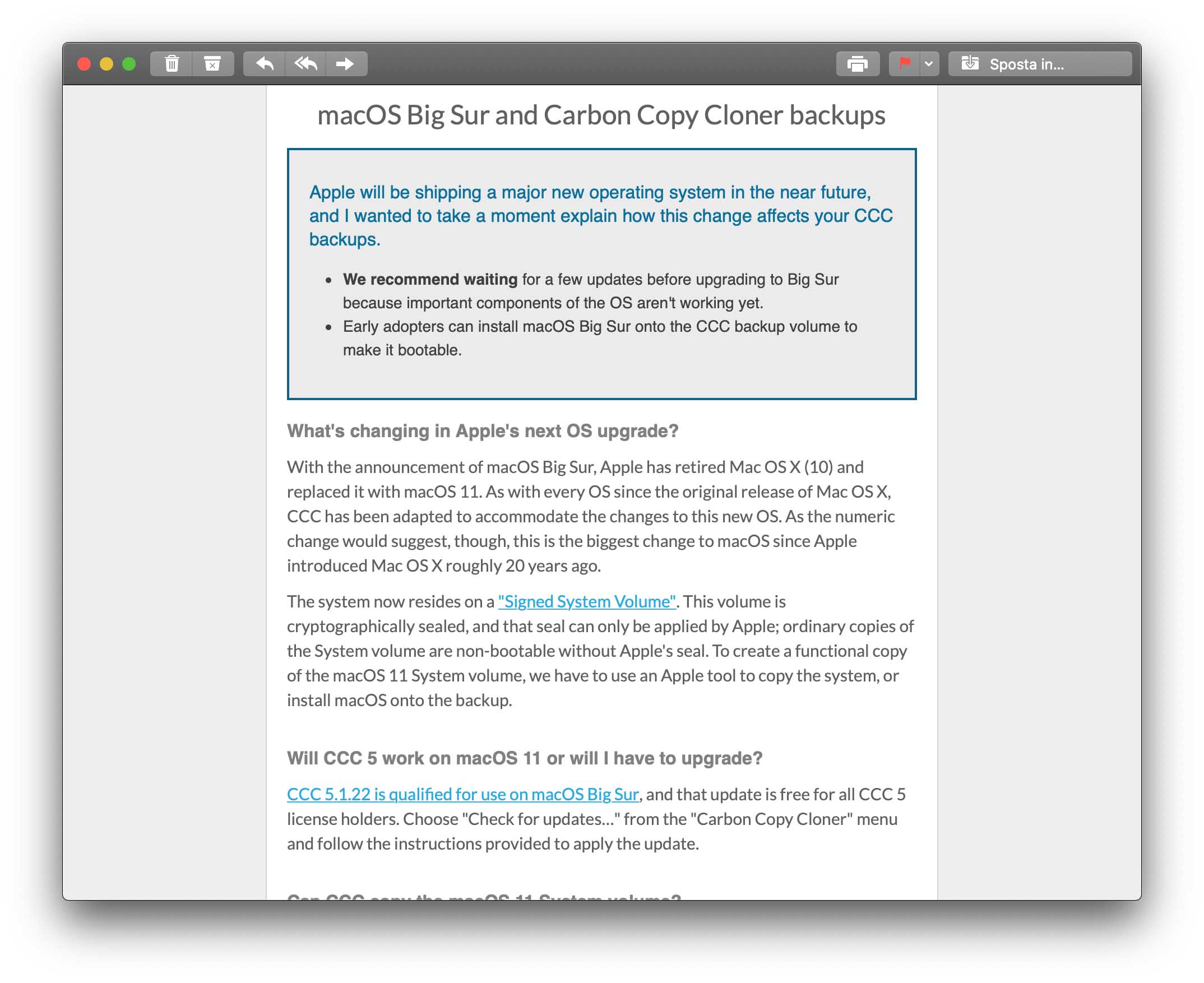Carbon Copy Cloner Big Sur
- CCC will be able to use Apple's APFS replication utility ('ASR') to copy the System volume (we field-tested that functionality for the flawed 10.15.5 update). As of the latest Big Sur release, however, Apple's APFS replication utility is not working correctly with the Signed System Volume.
- Related posts Helicopter Helicopter Market – COVID-19 Industry Impact Analysis, Market Trends, Market Growth, Opportunities and Forecast 2025 Samsung SDI to supply battery cells to start-up EV RivianNews Carbon Copy Cloner is popular software that allows Mac users to easily backup entire disks and partitions on macOS. While macOS Big Sur is about.
Latest version available Carbon Copy Cloner (5.1.22) works with macOS Big Sur, but is only capable of creating non-boot copies of the system volume. The developers responsible for the software have stated that Apple is aware of this limitation and is currently working to resolve it.
Creating a backup of your important files can be a lifesaver. Whenever you encounter an error, file corruption, or any problem that prevents you from accessing your files, you can always rely on your backup to avoid data loss. Among the many backup tools available for Mac, Carbon Copy Cloner or CCC is one of the most reliable.
Carbon Copy Cloner Review
What Is Carbon Copy Cloner?
Aside from being used to create file backups, Carbon Copy Cloner can also make complete images of your computer or clone your hard drives. This tool is quite flexible because you can either back up the whole disk or just a part of it to your external hard drive. It is capable of creating bootable backups and booting from your backup if a disaster strikes your hard disk.
To my knowledge the only app that can properly create a bootable clone of Big Sur is Carbon Copy Cloner and ONLY on Intel Machines, and only because the author of CCC has figured out how to use Apple's built in functions in Big Sur (on Intel) to properly make a clone bootable. @bombich has now posted a lengthy article explaining that CCC 5.1.22 is now officially qualified for macOS 11 Big Sur. That doesn’t mean it will make bootable duplicates on its own—Apple’s Apple System Restore tool isn’t functioning sufficiently for that to be true—but you can install macOS onto a CCC backup to make it bootable and end up in the same place.
You have the option to choose what time you want the backup to be processed — hourly, daily, weekly, monthly, and others.
CCC is equipped with a smart update function, which prevents you from copying all the files every time the backup is initiated. This means that the app will only update the newly added or modified files. You can also use Carbon Copy Cloner to create bootable backups. In case your hard disk fails or becomes inaccessible, you can boot from your bootable backup in no time.
Pro Tip: Scan your Mac for performance issues, junk files, harmful apps, and security threats
that can cause system issues or slow performance.
Special offer. About Outbyte, uninstall instructions, EULA, Privacy Policy.
Tip: Avoid copying unnecessary files to your backup drive and save some storage space by regularly cleaning your computer using a Mac optimizer tool. It also prevents potential issues and keeps macOS performing at its best.
CCC 5 is the latest version of this software and it works with macOS version Yosemite (10.10) up to the latest Big Sur (11.0). CCC 4 only works up to High Sierra (10.13).
With the upcoming public release of macOS Big Sur, Bombich Software, the developers behind Carbon Copy Cloner warns of compatibility issues with macOS Big Sur. CCC has reported these issues to Apple and they are still waiting for an official response. Let’s look at some of the known issues and what you can do about them.
Compatibility Issues with Carbon Copy Cloner on Big Sur
There are three main issues that users have to be aware of when using CCC 5 on macOS Big Sur. Let’s discuss them one by one and the workarounds offered by CCC.
Issue #1: Big Sur startup disk can’t be cloned
With CCC, users are able to create advanced backups of your hard drive while keeping it functional and bootable. This ensures that you never lose your data if an accident ever occurs. But with Big Sur, the Apple Software Restore does not have the capability to close the Big Sur startup disk because of a broken seal. Apple’s Signed System Volume, which is very proprietary in nature, is preventing ordinary system calls and copy software from cloning the macOS System volume.
The Signed System Volume has been implemented starting macOS 10.15.5, but CCC was able to work around this restriction by using Apple’s APFS replication software. But with Big Sur, ASR no longer creates a bootable copy of the macOS System volume.

Fix: Apple has recently released the macOS 11.0.1 which resolves some of the issues with Apple Software Restore or ASR utility. However, CCC is still testing whether this patch has resolved all errors and if CCC is now able to create bootable backups.
If installing this update does not fix the problem for you, you can try the workaround suggested by CCC. Make your backup drive bootable by directly installing Big Sur onto the backup disk. You can also employ the help of Migration Assistant to restore all of your data and files to a clean installation, without having the need to install macOS on your backup drive.

Issue #2: Creating a bootable backup requires erasing the destination drive
With the release of macOS Big Sur, the system is now located on a cryptographically sealed “Signed System Volume”. And this seal is applied by Apple itself. This means that when you clone the System volume, they are not bootable copies because they do not have Apple’s seal. To create a bootable macOS 11 System volume, CCC uses the ASR tool mentioned above. Unfortunately, the ASR only copies entire volume groups, which includes System and Data, not just the System volume. Because of this, CCC has to erase the whole destination volume, including the existing snapshots on that volume, whenever a macOS update is released, in order to update the system on the destination.
Fix: CCC has reached out to Apple to request that the ASR be allowed to clone the System volume only. CCC is only waiting for the implementation from Apple. While the fix is not rolled out yet, CCC recommends erasing the destination only when you establish the initial backup, then use the built-in file copier to maintain your backup of user data, applications, and system settings. If you wish to update the macOS on the backup drive, boot your Mac from the backup drive and install any updates using Software Update in the System Preferences app.
Issue #3: Inconsistent display of ASR clones in the Startup Disk Preference pane
In the previous CCC versions, the Startup Disk Preference Pane shows all the available startup volumes, including those that were cloned by CCC, regardless of how they were copied ( via ASR or file copier). But in Big Sur, there are instances when the cloned volumes do not show in the Startup Disk Preference Pane, even though they are bootable.
Fix: If you want to boot from the cloned volume, reboot your Mac while pressing the Option key, then choose the cloned volume found in the Startup Manager. Then, you can set the startup disk to the current startup volume.
Summary

Although Carbon Copy Cloner has released a version that works with macOS Big Sur, the developers are aware of the compatibility issues and limitations of the backup tool. It is working together with Apple to address these issues and hopefully iron everything out when Big Sur is finally released to the public. For now, we hope that the suggested workarounds above should help.
Carbon Copy Cloner For Big Sur
See more information about Outbyte and uninstall instructions. Please review EULA and Privacy Policy.
With the announcement of macOS Big Sur, Apple has retired Mac OS X (10) and replaced it with macOS 11. As the numeric change would suggest, this is the biggest change to macOS since Apple introduced Mac OS X roughly 20 years ago. The system now resides on a cryptographically sealed 'Signed System Volume'. That seal can only be applied by Apple; ordinary copies of the System volume are non-bootable without Apple's seal. To create a functional copy of the macOS 11 System volume, we have to use an Apple tool to copy the system, or install macOS onto the backup.
How are bootable backups different on macOS Big Sur?
CCC uses Apple's APFS replication utility, 'ASR', to establish an initial bootable clone of your startup disk. This utility does not offer as much flexibility as you've grown accustomed to with CCC on older OSes, in particular it requires that the destination is erased and that everything is copied from the source to the destination. When you configure a new backup of your startup disk on Big Sur, CCC will offer a few options, depending on the size and current format of your destination device:
- Allow CCC to erase the destination to make a bootable clone
- Add a new, dedicated backup volume to an existing APFS destination (if there is enough free space)
- Proceed with a Data Volume backup (this is a complete backup of all of your data, applications, and system settings)
To learn more about these options, and what to expect when running your first 'Full Volume Clone' see Cloning macOS System volumes with Apple Software Restore.
Does my CCC backup have to be bootable for me to restore data from it?
No. Bootability is a convenience that allows you to continue working if your startup disk fails, but it is not required for restoring data from a CCC backup. You can restore individual folders and older versions of files (i.e. from snapshots) using CCC while booted from your production startup disk. CCC backups are also compatible with Migration Assistant, so you can use Migration Assistant to restore all of your data to a clean installation of macOS (e.g. on a replacement disk).
After CCC has established an initial bootable backup, will it keep the destination System volume up to date?
Carbon Copy Cloner Big Sur
No. We would like to offer this functionality, but doing so involves a tradeoff that we think most users would find unacceptable. Due to an inflexibility in Apple's APFS replication utility (ASR), we can only update the destination System volume by cloning both the System and Data volumes together with ASR, and that involves erasing the destination. Doing so would remove all snapshots on the destination, and would take quite a bit longer than an ordinary incremental backup.
Fortunately, updating the System volume on the destination is not something that you have to do frequently, nor even proactively, it's something that you can do if and when required. Simply boot your Mac from the backup volume and apply any updates via the Software Update preference pane in the System Preferences application. This is something that you could even defer until the need arises to restore from the backup.
How do I upgrade my Catalina (or older) backup to Big Sur?
After you upgrade your Mac to Big Sur, and only after you have decided to commit to the Big Sur OS, you may resume the backup of your startup disk to your CCC backup volume. Open CCC and review each of your backup tasks to see if any adjustments are required for the first backup on the new OS.
Related resources
